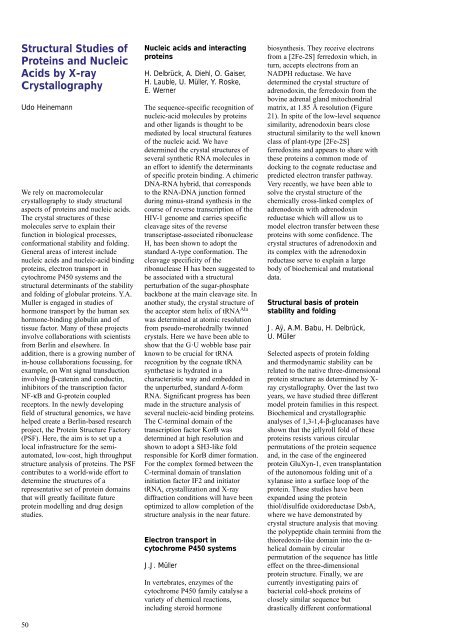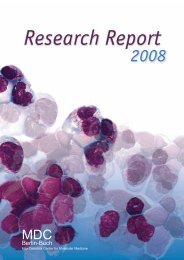You also want an ePaper? Increase the reach of your titles
YUMPU automatically turns print PDFs into web optimized ePapers that Google loves.
Structural Studies of<br />
Proteins and Nucleic<br />
Acids by X-ray<br />
Crystallography<br />
Udo Heinemann<br />
We rely on macromolecular<br />
crystallography to study structural<br />
aspects of proteins and nucleic acids.<br />
The crystal structures of these<br />
molecules serve to explain their<br />
function in biological processes,<br />
conformational stability and folding.<br />
General areas of interest include<br />
nucleic acids and nucleic-acid binding<br />
proteins, electron transport in<br />
cytochrome P450 systems and the<br />
structural determinants of the stability<br />
and folding of globular proteins. Y.A.<br />
Muller is engaged in studies of<br />
hormone transport by the human sex<br />
hormone-binding globulin and of<br />
tissue factor. Many of these projects<br />
involve collaborations with scientists<br />
from Berlin and elsewhere. In<br />
addition, there is a growing number of<br />
in-house collaborations focussing, for<br />
example, on Wnt signal transduction<br />
involving β-catenin and conductin,<br />
inhibitors of the transcription factor<br />
NF-κB and G-protein coupled<br />
receptors. In the newly developing<br />
field of structural genomics, we have<br />
helped create a Berlin-based research<br />
project, the Protein Structure Factory<br />
(PSF). Here, the aim is to set up a<br />
local infrastructure for the semiautomated,<br />
low-cost, high throughput<br />
structure analysis of proteins. The PSF<br />
contributes to a world-wide effort to<br />
determine the structures of a<br />
representative set of protein domains<br />
that will greatly facilitate future<br />
protein modelling and drug design<br />
studies.<br />
50<br />
Nucleic acids and interacting<br />
proteins<br />
H. Delbrück, A. Diehl, O. Gaiser,<br />
H. Lauble, U. Müller, Y. Roske,<br />
E. Werner<br />
The sequence-specific recognition of<br />
nucleic-acid molecules by proteins<br />
and other ligands is thought to be<br />
mediated by local structural features<br />
of the nucleic acid. We have<br />
determined the crystal structures of<br />
several synthetic RNA molecules in<br />
an effort to identify the determinants<br />
of specific protein binding. A chimeric<br />
DNA-RNA hybrid, that corresponds<br />
to the RNA-DNA junction formed<br />
during minus-strand synthesis in the<br />
course of reverse transcription of the<br />
HIV-1 genome and carries specific<br />
cleavage sites of the reverse<br />
transcriptase-associated ribonuclease<br />
H, has been shown to adopt the<br />
standard A-type conformation. The<br />
cleavage specificity of the<br />
ribonuclease H has been suggested to<br />
be associated with a structural<br />
perturbation of the sugar-phosphate<br />
backbone at the main cleavage site. In<br />
another study, the crystal structure of<br />
the acceptor stem helix of tRNA Ala<br />
was determined at atomic resolution<br />
from pseudo-merohedrally twinned<br />
crystals. Here we have been able to<br />
show that the G·U wobble base pair<br />
known to be crucial for tRNA<br />
recognition by the cognate tRNA<br />
synthetase is hydrated in a<br />
characteristic way and embedded in<br />
the unperturbed, standard A-form<br />
RNA. Significant progress has been<br />
made in the structure analysis of<br />
several nucleic-acid binding proteins.<br />
The C-terminal domain of the<br />
transcription factor KorB was<br />
determined at high resolution and<br />
shown to adopt a SH3-like fold<br />
responsible for KorB dimer formation.<br />
For the complex formed between the<br />
C-terminal domain of translation<br />
initiation factor IF2 and initiator<br />
tRNA, crystallization and X-ray<br />
diffraction conditions will have been<br />
optimized to allow completion of the<br />
structure analysis in the near future.<br />
Electron transport in<br />
cytochrome P450 systems<br />
J.J. Müller<br />
In vertebrates, enzymes of the<br />
cytochrome P450 family catalyse a<br />
variety of chemical reactions,<br />
including steroid hormone<br />
biosynthesis. They receive electrons<br />
from a [2Fe-2S] ferredoxin which, in<br />
turn, accepts electrons from an<br />
NADPH reductase. We have<br />
determined the crystal structure of<br />
adrenodoxin, the ferredoxin from the<br />
bovine adrenal gland mitochondrial<br />
matrix, at 1.85 Å resolution (Figure<br />
21). In spite of the low-level sequence<br />
similarity, adrenodoxin bears close<br />
structural similarity to the well known<br />
class of plant-type [2Fe-2S]<br />
ferredoxins and appears to share with<br />
these proteins a common mode of<br />
docking to the cognate reductase and<br />
predicted electron transfer pathway.<br />
Very recently, we have been able to<br />
solve the crystal structure of the<br />
chemically cross-linked complex of<br />
adrenodoxin with adrenodoxin<br />
reductase which will allow us to<br />
model electron transfer between these<br />
proteins with some confidence. The<br />
crystal structures of adrenodoxin and<br />
its complex with the adrenodoxin<br />
reductase serve to explain a large<br />
body of biochemical and mutational<br />
data.<br />
Structural basis of protein<br />
stability and folding<br />
J. Aÿ, A.M. Babu, H. Delbrück,<br />
U. Müller<br />
Selected aspects of protein folding<br />
and thermodynamic stability can be<br />
related to the native three-dimensional<br />
protein structure as determined by Xray<br />
crystallography. Over the last two<br />
years, we have studied three different<br />
model protein families in this respect.<br />
Biochemical and crystallographic<br />
analyses of 1,3-1,4-β-glucanases have<br />
shown that the jellyroll fold of these<br />
proteins resists various circular<br />
permutations of the protein sequence<br />
and, in the case of the engineered<br />
protein GluXyn-1, even transplantation<br />
of the autonomous folding unit of a<br />
xylanase into a surface loop of the<br />
protein. These studies have been<br />
expanded using the protein<br />
thiol/disulfide oxidoreductase DsbA,<br />
where we have demonstrated by<br />
crystal structure analysis that moving<br />
the polypeptide chain termini from the<br />
thioredoxin-like domain into the αhelical<br />
domain by circular<br />
permutation of the sequence has little<br />
effect on the three-dimensional<br />
protein structure. Finally, we are<br />
currently investigating pairs of<br />
bacterial cold-shock proteins of<br />
closely similar sequence but<br />
drastically different conformational

















